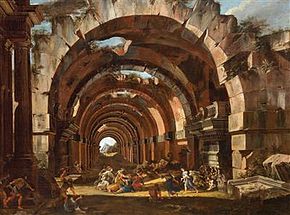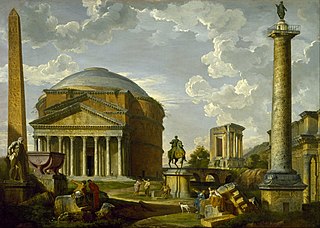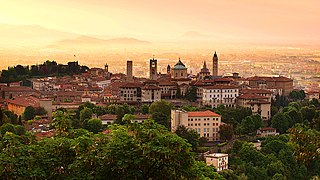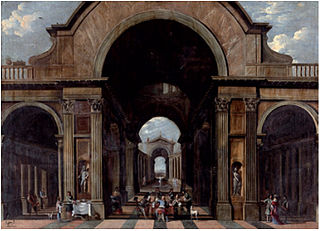
Salvator Rosa was an Italian Baroque painter, poet, and printmaker, who was active in Naples, Rome, and Florence. As a painter, he is best known as "unorthodox and extravagant" as well as being a "perpetual rebel" and a proto-Romantic.

Artemisia Gentileschi or Artemisia Lomi was an Italian Baroque painter, today considered one of the most accomplished painters in the generation following that of Caravaggio. In an era when female painters were not easily accepted by the artistic community or patrons, she was the first woman to become a member of the Accademia di Arte del Disegno in Florence and had international clientele.

Jan Frans van Bloemen was a Flemish landscape painter mainly active in Rome. Here he was able to establish himself as the leading painter of views (vedute) of the Roman countryside depicted in the aesthetic of the classical landscape tradition.

A veduta is a highly detailed, usually large-scale painting or, more often print, of a cityscape or some other vista. The painters of vedute are referred to as vedutisti.

Abraham Brueghel was a Flemish painter from the famous Brueghel family of artists. He emigrated at a young age to Italy where he played an important role in the development of the style of decorative Baroque still lifes.
Events from the year 1606 in art.
Gaspar Roomer was a prominent Flemish merchant, banker, art patron and art collector who was active in Naples in the 17th century.

Michelangelo Cerquozzi, known as Michelangelo delle Battaglie was an Italian Baroque painter known for his genre scenes, battle pictures, small religious and mythological works and still lifes. His genre scenes were influenced by the work of the Flemish and Dutch genre artists referred to as the Bamboccianti active in Rome who created small cabinet paintings and prints of the everyday life of the lower classes in Rome and its countryside. One of the leading battle painters active in Italy in the first half of the 17th century, Michelangelo Cerquozzi earned the nickname 'Michelangelo delle Battaglie'.

François de Nomé was a French painter of the Baroque period, active mainly in Naples.
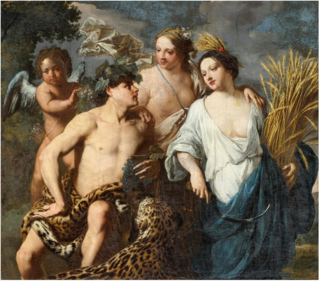
Jan Miel was a Flemish painter and engraver who was active in Italy. He initially formed part of the circle of Dutch and Flemish genre painters in Rome who are referred to as the 'Bamboccianti' and were known for their scenes depicting the lower classes in Rome. He later developed away from the Bamboccianti style and painted history subjects in a classicising style.
Filippo Gagliardi was an Italian painter of the Baroque period, active mainly in Rome. He collaborated with Filippo Lauri, Andrea Sacchi and Giovanni Benedetto Castiglione. He also helped in the renovation of San Martino ai Monti (1647–54). He contributed illustrated architectural perspectives to Ferrari's Hesperides (1646). He was a member of the Accademia di San Luca from at least 1638 and became principe in 1656–58. He was also a member of the Congregazione dei Virtuosi del Pantheon. He produced numerous architectural paintings showing grand structures in strong chiaroscuro, including a set of four in the Palazzo Rospigliosi-Pallavicini in Rome, with figure by the Genoese painter Giovanni Benedetto Castiglione, and two in the Musée de Peinture e de Sculpture, Grenoble. He was also known as 'Filippo delle Prospettive'. His works are sometimes confused with those by Viviano Codazzi. He also appears to confused with Giovanni Francesco Gagliardi.
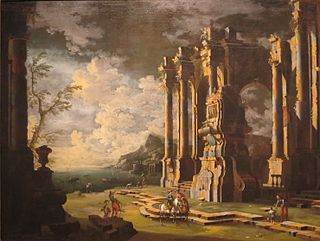
Leonardo Coccorante (1680–1750) was an Italian painter known for his capricci depicting imaginary landscapes with ruins of classical architecture.

Alessandro Salucci was an Italian painter who played an important role in the development of the genre of cityscapes (vedute) of Rome. He created capricci, i.e. imaginary architectural perspectives and harbour views, in which the figures were often executed by another artist.
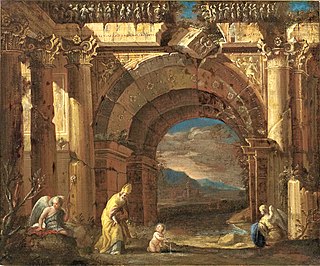
Ascanio Luciano or Ascanio Luciani was an Italian architectural painter who was active during the Baroque period. He is known for his architectural paintings, capricci, compositions with figures among ruins, and some vedute. He worked in Naples throughout his career. He is regarded as playing an important a hinge role in the genre of architectural capricci between leading founders of the genre such as Viviano Codazzi and François de Nomé and the 18th-century specialists of the genre.
